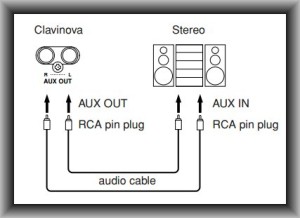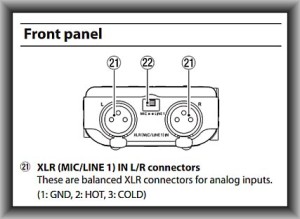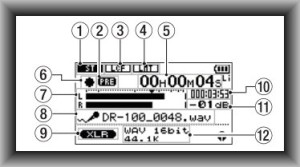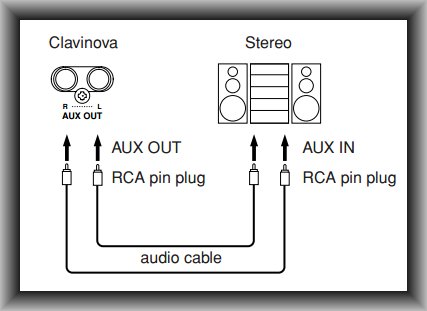This is a tutorial illustrating the use of direct box in a home recording application. I received an inquiry from a reader about issues on recording a digital piano. Below are the gears and accessories used:
1.) CLP-295GP Yamaha Clavinova digital piano.
2.) Tascam DR-100MKII recorder
Original Recording Path
The reader is actually thinking of recording the digital piano in stereo by using this flow:
Piano > LINE OUT (2 female RCA outputs) > digital recorder > DAW > CD
The recording concept is simple; first connect the piano RCA outputs to a digital recorder line inputs. Final processing (editing, mixing, etc) will need files to be transferred to a computer with DAW software (e.g. Reaper). After completing the DAW session such as mixing and mastering, it can be burned into to a CD.
However, he was thinking about adding a “preamp” before the recorder to increase the quality and fidelity of the sound recording:
Piano > LINE OUT (2 female RCA outputs) > Preamp > digital recorder > DAW > CD
Now he is asking recommendations as to what types and brands of preamps to buy. Do you think a preamp is really needed in this case?
Understanding the Instruments/Gears Inputs and Outputs
The very basic function of the preamp is to take a microphone or instrument level signal input (read more about this topic here) and boost it line levels. It’s important to examine the nature of the outputs and signals involved before you can decide whether a preamp is highly necessary.
One of the important clues can be found in the gear manuals. Example below is the information obtained:
A.) Yamaha Clavinova Digital Piano outputs

There is only one set of analog outputs on this instrument and that is using the AUX out that consists of 2 RCA jacks. These are line, unbalanced outputs. The manual recommends connecting using an RCA to RCA cable from connecting the instrument to a stereo recorder. But this is not the case if you are recording to a digital recorder requiring balanced inputs.
RCA is carrying unbalanced signals and could be susceptible to noise and interference. This is a common source of noise if you are recording using unbalanced outputs. This is not to say that recording unbalanced should be entirely avoided but if you want the capture the cleanest sound as possible from your instrument, you need to record using balanced inputs and audio outputs.
B.) Tascam DR-100MKII recorder inputs
Below are the standard inputs of this digital recorder:

As usual with any other professional audio equipment, it utilizes XLR balanced inputs that can have two modes:
1.) LINE 1
2.) MIC
According to the manual, LINE 1 is used when you are recording from balanced external audio sources. MIC mode is used when you are connecting a MIC level signal to the digital recorder (not necessarily coming from a microphone).
It is also worth noting that this digital recorder already includes a preamp because it accepts MIC level signals. All professional audio recording interfaces and digital recorders today (as long as they accept microphone XLR balanced inputs) are equipped with a built-in preamp. Therefore, buying an external preamp unit is redundant in this case.
The Recommended Recording Setup – using Direct Box
It is always desirable to have the cleanest sound recording of the musical instrument. One of the gears that could help is using a direct box.
The role of this device is to accept unbalanced RCA/TS line inputs (such as from the digital piano) and then convert this to balanced XLR MIC level (not line level) outputs suitable as an input for professional digital recorder like the Tascam DR-100MKII. The following are the benefits:
1.) Clean recorded signals.
2.) Preserve the original sound of the instrument.
Also using RCA to XLR ready-made adapter cables won’t help because it does not do anything to condition/prepare the signals or matched the impedance to the digital recorder inputs. You really need a direct box to make this conversion correctly and as clean as possible.
In this case, below is the recommended recording setup flow (recording in stereo):

The following are the detailed procedures:
1.) Turn off the digital piano as well as the digital recorder. Do not yet connect the computer to your digital recorder.
2.) Connect the RCA outputs of the digital piano to RCA inputs of the direct box. There are lots of direct box to choose. The important requirement is that it accepts RCA unbalanced connectors as input and provides balanced-XLR outputs. Whirlwind PCDI Direct Box is an example. This is a passive direct box which does not need any external power to operate.
Switch off the pad switch (defaults at O position). You can tweak this later on if necessary.

3.) Connect the output of the direct box (XLR outputs) to the digital recorder XLR balanced inputs, in this case Tascam DR-100MKII. Also connect the recorder to any studio monitors or headphones for monitoring.
4.) Turn on the gears and instruments and then implement the following settings(tweak this later on if necessary):
a.) Volume output from digital piano set at 50% maximum.
b.) Set this setting on the direct box:
-Stereo switch on- this will let you record in stereo.
-Pad switch to “O” position.
c.) On the digital recorder, switch the XLR input mode to MIC and then set the MIC gain to M (which means medium). This is located at the bottom panel of the digital recorder.
5.) To optimize the recording level, try to do a test recording and adjust as follows:
a.) This recorder has a peak indicator that will light red if the recording signal is too strong that clipping and distortion will occur. If it lights red somewhere in your performances (especially the loud sections), try switching the pad switch in “I” (on) position to attenuate the incoming inputs to the digital recorder.
It also features “peak value in decibels in dB” (see #11 indicator below from the manual) that will actually provide a value of the maximum peak recording level.

For the purpose of proper gain staging (read here), it is recommended to limit this at -6dB as the maximum (the loudest section of the performance) level.
c.) You can as well experiment setting the preamp microphone gain level from MID to LOW or even HIGH and see the resulting maximum peak recording level.
Bear in mind that this digital recorder save all recording in SD cards (instead of the normal computer hard drive). After completing all the recording sessions, you can then connect the recorder to the computer via the USB port. At this point, you can transfer the files to your computer for mixing/mastering with DAW software.
FAQ/Troubleshooting Tips
1.) There is some hum in the recording?
In case of hum or noise, you can press the LIFT switch in the direct box. Try recording also recording the instrument in mono.
2.) What is the optimal bit depth and sample rate for this recorder?
Solution: Record at least 24-bits/44.1KHz or 24-bits/48KHz. If you can afford recording at 96 KHz, go ahead but you might be running out of space very early. This will also depend on the size of your SD drive.
3.) Why should I enable the XLR input to MIC mode if I’m not recording with a microphone?
The output of the direct box is presumably in microphone levels (a weaker signal level) so to match the inputs you need to enable the XLR to MIC mode on the digital recorder. This will ensure that the recorded audio (from direct box) will pass the recorder preamp.
4.) What will happen if I record in XLR LINE IN mode instead of XLR MIC levels?
If you enable line in for digital recorder inputs, it will bypass its preamp circuitry because it won’t anymore boost line level signals. This will result to weak and undesirable recording output on the recorder.
5.) Why not just connect the line output of the piano directly to the line input of the Tascam recorder using appropriate connectors without direct box?
The output of the piano is using RCA unbalanced outputs. The input of the recorder is using balanced XLR inputs. Connecting unbalanced to balanced inputs without direct box is not recommended for best recording quality. Cable lengths, impedance issues and interference can be a big factor affecting the end result of the sound recording. Sonic integrity of the original sound source can be best preserved by using a direct box.
6.) Are all direct boxes sound the same?
Yes ideally, but differences in electronic design (transformers, components, etc) can define the sound of the direct box just like any analog gears. I recommend testing one direct box to another before actually making a purchase and assess which sounds good to you.
7.) Can I use an active direct box with preamp on it?
This is not important because you already have the digital recorder preamps to condition the inputs.
8.) Can I connect a microphone to a direct box?
No, instead what you need is them to a preamp. Microphone outputs (condenser and dynamic) are already using XLR balanced outputs. You need a preamp to boost the MIC input to LINE levels.
9.) I’m confused, you want me to connect to an XLR MIC level but the sound source is not coming from a microphone?
MIC level is synonymous to a weak audio signal. This is a common term used for DI box outputs; regardless of the input source (even when it’s not a microphone).
10. What other instruments can I record using a direct box?
Any musical instrument; for example an electric guitar is using unbalanced high impedance TS output connectors. To maintain sonic integrity, you can use a direct box before connecting it to a mixer, a guitar amplifier or a digital recorder.
Any powered instrument (including piano keyboards in this case) source with Hi-Z unbalanced outputs can benefit by using a direct box if it is to be recorded to professional audio equipment requiring balanced low-Z inputs. Some common applications:
Electric guitar) > Direct box (low-z balanced > Mixer, Preamps or audio interface
Acoustic guitar with active pickup (hi-z unbalanced) > Direct box > Mixing console/recorder or audio interface
Consumer audio equipment (iPod, Discman, Laptops) > Direct box > Mixer or any other pro audio equipment requiring balanced inputs
With the techniques, you can record your instrument sound at its best quality without compromising it with noise and serious change in tone.









2 Responses
You are welcome Eddie, good luck to your projects!
Hello Emerson:
Thank you so much for this wealth of knowledge. I will buy the equipment you recommend. Your assistance has been extraordinary and I will continue to study your articles.
Thanks so much,
eddie